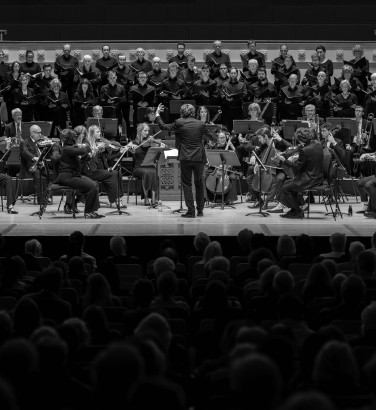
All that jazz: the music of Les Six
14 Dec 2022
News Story
When Stravinsky took Paris by storm with his ballet scores in the 1910s, his influence came to be be felt on a good deal of French music which followed. What sets France’s native composers apart from the Russian, however, is the way they embraced what might now be regarded as light classical music: while their orchestral writing is indebted to Stravinsky, the music itself shows a clear appreciation for cabaret, popular song and what would come to be recognised as jazz.
Les Six was a name that came to be associated with the best-known of them, bright young things resident in 1920s Paris. Louis Durey and Germaine Tailleferre - the only woman in the group - are little known today, and while Georges Auric would become more celebrated for his film scores (several Ealing comedies among them), Darius Milhaud’s fame, such as it is, has never really crossed the Channel.
This leaves Arthur Honegger (often viewed as a one-hit wonder thanks to Pacific 231, his powerful vision of a steam train) and the much better-known Francis Poulenc, who perhaps best represents the group’s approach to their art. Nonchalantly elegant, endlessly charming and very French, the man and his music would come to embody the optimistic spirit of the age long after it had passed.
This music is at once charming and ill-mannered, gay and bitter, simple and scurrilous. There is much wit in it; many clever musical quotations [...] and not a little sarcasm.
At the time, however, Milhaud’s ballet Le bœuf sur le toit (The Ox on the Roof, after a popular Brazilian song of the time) was deemed to encapsulate Les Six - at least by the American Louis Moyles, who opened a cabaret bar of the same name in Paris in 1921. If, as has been suggested, this was merely to ensure the composers' patronage, it was a gamble that paid off handsomely: the locale fast became the place to be for an enormous variety of musicians, from Maurice Chevalier to Stravinsky himself, and could count the likes of Ernest Hemingway, Coco Chanel and Pablo Picasso among its regulars.
After-hours sessions at Le bœuf became so infamous that faire un bœuf (‘to do an Ox’) remains the French for jamming to this day. It was at gatherings such as these that Clément Doucet’s jazzed-up reinterpretations of others’ music were performed.
After flirting with jazz in Le bœuf sur le toit, Milhaud fully embraced it in his 1923 ballet La Création du monde (The Creation of the World), having visited New York the previous year with the specific purpose of exploring this new idiom - hence the inclusion of a jazz trio (piano, percussion and double bass) in the score, to say nothing of a prominent solo part for alto sax. A popular success (if not with the critics), it is now much better known as a purely orchestral piece shorn of its choreography, a retelling of the world's beginnings according to African folk mythology.
Despite being a prolific composer, Milhaud's work as a teacher can be seen as even more significant, with Burt Bacharach and Steve Reich among his students. Their own styles - populist and modernist respectively - may differ considerably, but Milhaud's own music effortlessly combines the two.
Poulenc's music and personality embody a dichotomy of their own: famously described as combining the qualities of a monk and a voyou (which can variously translated as thug, layabout or rascal), this is a reflection of his serious and frivolous sides. The former would only emerge when he rediscovered his Catholic faith in the mid-1930s, but there is no sign of it in his 1947 Sinfonietta, a work typical of Poulenc the entertainer.
It's not exactly jazz, but as is typical of the composer, it's full of the sort of catchy tunes which would not feel out of place sung in a smoky club by an arch chanteuse, the music spinning on a dime from biting satire to unexpected sentimentality and back again. Despite being Poulenc's most substantial orchestral work, it does not take itself particularly seriously - perhaps unexpectedly for a commission by the BBC, but somehow this only adds to the irony.
Related Stories
![]()
The bassoon concerto
19 May 2025
For the last article in our concerto series (for now), we turn to an instrument too often dismissed as the orchestra's resident joker.![]()
The SCO Chorus on music for Lent
10 March 2025
With Easter just around the corner, we delve into perhaps the richest (and often darkest) choral repertoire of all ...![]()
The oboe concerto
13 January 2025
The oboe: refined, yes, but cheeky or melancholic? Join us as we look at the concertos exploring this instrument's wide-ranging moods.


